

Compact Muon Solenoid
LHC, CERN
| CMS-PPS-17-001 ; CERN-EP-2018-014 | ||
| Observation of proton-tagged, central (semi)exclusive production of high-mass lepton pairs in pp collisions at 13 TeV with the CMS-TOTEM precision proton spectrometer | ||
| CMS and TOTEM Collaborations | ||
| 13 March 2018 | ||
| JHEP 07 (2018) 153 | ||
| Abstract: The process ${\mathrm{p}}{\mathrm{p}} \to {\mathrm{p}} \ell^{+}\ell^{-} {\mathrm{p}}^{(*)}$, with $\ell^{+}\ell^{-}$ a muon or an electron pair produced at midrapidity with mass larger than 110 GeV, has been observed for the first time at the LHC in pp collisions at $\sqrt{s} = $ 13 TeV. One of the two scattered protons is measured in the CMS-TOTEM precision proton spectrometer (CT-PPS), which operated for the first time in 2016. The second proton either remains intact or is excited and then dissociates into a low-mass state ${\mathrm{p}}^{*}$, which is undetected. The measurement is based on an integrated luminosity of 9.4 fb$^{-1}$ collected during standard, high-luminosity LHC operation. A total of 12 $ \mu^{+} \mu^{-} $ and 8 $ \mathrm{e}^{+} \mathrm{e}^{-}$ pairs with $m(\ell^{+}\ell^{-}) > $ 110 GeV, and matching forward proton kinematics, are observed, with expected backgrounds of 1.49 $\pm$ 0.07 (stat) $\pm$ 0.53 (syst) and 2.36 $\pm$ 0.09 (stat) $\pm$ 0.47 (syst), respectively. This corresponds to an excess of more than five standard deviations over the expected background. The present result constitutes the first observation of proton-tagged $\gamma\gamma$ collisions at the electroweak scale. This measurement also demonstrates that CT-PPS performs according to the design specifications. | ||
| Links: e-print arXiv:1803.04496 [hep-ex] (PDF) ; CDS record ; inSPIRE record ; CADI line (restricted) ; | ||
| Figures | |

png pdf |
Figure 1:
Production of lepton pairs by $ {\gamma} {\gamma} $ fusion. The exclusive (left), single proton dissociation or semiexclusive (middle), and double proton dissociation (right) topologies are shown. The left and middle processes result in at least one intact final-state proton, and are considered signal in this analysis. The rightmost diagram is considered to be a background process. |

png pdf |
Figure 2:
Schematic layout (not to scale) of the beam line as seen from above between the interaction point (IP5) and the region where the RPs are located in LHC sector 56. Dipole magnets (D1, D2) of single- (MBXW) and twin-aperture, quadrupoles (Q1-Q6), collimators (TCL4-TCL6), absorbers (TAS, TAN), and quadrupole feedboxes (DFBX) are shown. The 210 near and 210 far units are indicated, along with the timing RPs not used here. The 220 near and 220 far units (not used here) are also shown. The RPs indicated in red are the horizontal CT-PPS ones; those in blue are part of the TOTEM experiment. The red (blue) arrow indicates the outgoing (incoming) beam. In the CMS coordinate system, the $z$ axis points to the left. The arm in the opposite LHC sector 45 (not shown) is symmetric with respect to the IP. |

png pdf |
Figure 3:
Schematic layout of the silicon strip detectors in one RP station. Both the horizontal RP and the vertical RPs, which are used only for special low-luminosity calibration fills, are shown. In the top RP, the silicon strips oriented at $+45^{\circ}$ and $-45^{\circ}$ angles are indicated by the diagonal lines. Tracks in the overlap region, indicated by the shaded area, are used to perform a relative alignment of the RPs in the calibration fills. |

png pdf |
Figure 4:
Distribution of the track impact points as a function of the horizontal coordinate for the alignment fill (black points), a physics fill before alignment (blue points), and after alignment (red points). The beam center is at $x = $ 0 for the black and red points; the $x$ axis origin is undefined for the blue points. In the alignment procedure the overall normalization of the histogram is irrelevant; the histograms from different fills are therefore rescaled to compare their shapes. |
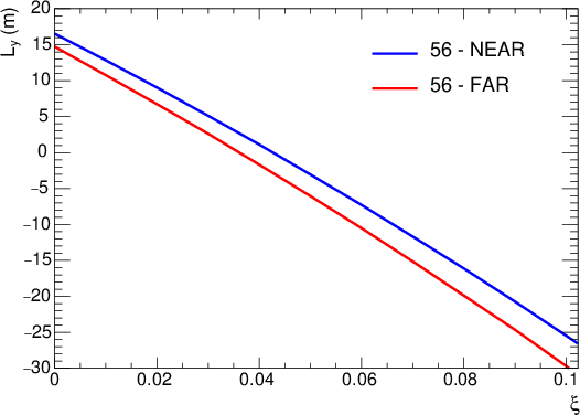
png pdf |
Figure 5:
Vertical effective length $L_{y}$ (in meters) as a function of the proton relative momentum loss $\xi $ at two (near and far) RPs calculated with the beam line optics simulation program MAD-X [22]. |

png pdf |
Figure 6:
Distribution of the track impact points measured in RP 210F, in sector 45, for the alignment fill. The point where $L_{y} = $ 0 is shown with a cross. The beam center is at $x = y = $ 0. The edge of the distribution is slanted because the RP shown has a rotation of 8$^{\circ}$ with respect to the vertical. |

png pdf |
Figure 7:
Example of track impact point distribution (in the $x, y$ plane) measured in RP 210F, sector 45, at 15$\sigma $ from the beam in the $x$ direction. The beam center is at $x = y = $ 0. The track selection includes a matching requirement with RP 210N, which suppresses noise and beam backgrounds, but slightly reduces the acceptance for low values of the position $x$, given the different acceptance of the near and far RPs. |

png pdf |
Figure 8:
Dimuon (left) and dielectron (right) acoplanarity versus the distance between the closest extra track and the dilepton vertex for simulated signal and backgrounds. The points represent the Drell-Yan (red), exclusive $ {\gamma} {\gamma} \to \ell ^{+}\ell ^{-}$ (blue), single-dissociative $ {\gamma} {\gamma} \to \ell ^{+}\ell ^{-}$ (green), and double-dissociative $ {\gamma} {\gamma} \to \ell ^{+}\ell ^{-}$ (yellow) processes. The dashed lines indicate the region selected for the analysis. The number of points for each physics process does not reflect its cross section. |

png pdf |
Figure 9:
Dimuon (left) and dielectron (right) invariant mass (top) and rapidity (bottom), after all central-detector criteria are applied, in pp collisions at 13 TeV. Points with error bars indicate the measured data (with statistical uncertainties only), and the stacked histograms show the different simulated contributions for signal and backgrounds (with statistical uncertainty of similar size as the data). The lower panel in each plot shows the ratio of the data to the sum of all signal and background predictions. |

png pdf |
Figure 9-a:
Dimuon invariant mass, after all central-detector criteria are applied, in pp collisions at 13 TeV. Points with error bars indicate the measured data (with statistical uncertainties only), and the stacked histograms show the different simulated contributions for signal and backgrounds (with statistical uncertainty of similar size as the data). The lower panel shows the ratio of the data to the sum of all signal and background predictions. |
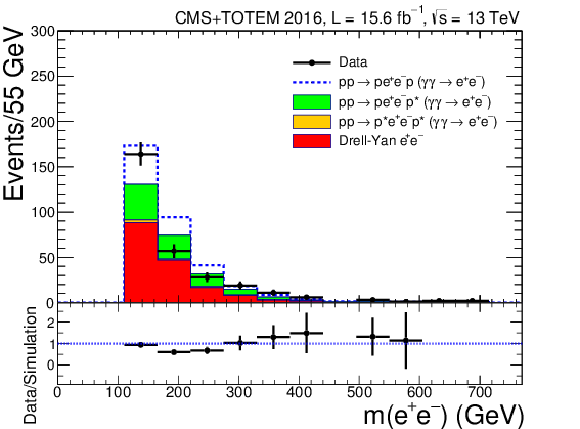
png pdf |
Figure 9-b:
Dielectron invariant mass, after all central-detector criteria are applied, in pp collisions at 13 TeV. Points with error bars indicate the measured data (with statistical uncertainties only), and the stacked histograms show the different simulated contributions for signal and backgrounds (with statistical uncertainty of similar size as the data). The lower panel shows the ratio of the data to the sum of all signal and background predictions. |

png pdf |
Figure 9-c:
Dimuon rapidity, after all central-detector criteria are applied, in pp collisions at 13 TeV. Points with error bars indicate the measured data (with statistical uncertainties only), and the stacked histograms show the different simulated contributions for signal and backgrounds (with statistical uncertainty of similar size as the data). The lower panel shows the ratio of the data to the sum of all signal and background predictions. |
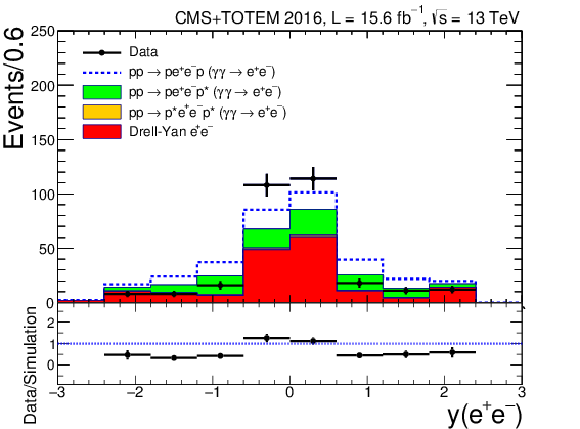
png pdf |
Figure 9-d:
Dielectron rapidity, after all central-detector criteria are applied, in pp collisions at 13 TeV. Points with error bars indicate the measured data (with statistical uncertainties only), and the stacked histograms show the different simulated contributions for signal and backgrounds (with statistical uncertainty of similar size as the data). The lower panel shows the ratio of the data to the sum of all signal and background predictions. |
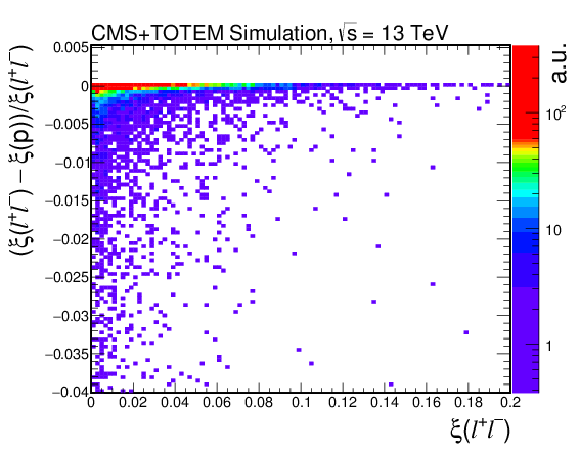
png pdf |
Figure 10:
Generator-level relative difference $(\xi (\ell ^{+}\ell ^{-}) - \xi ({\mathrm {p}}))/(\xi (\ell ^{+}\ell ^{-}))$ vs. $\xi (\ell ^{+}\ell ^{-})$ for simulated single dissociative $ {\gamma} {\gamma} \to \ell ^{+}\ell ^{-}$ events. Of the two possible solutions for $\xi (\ell ^{+}\ell ^{-})$, only the one corresponding to the side with the intact proton is shown. |

png pdf |
Figure 11:
Correlation between the fractional values of the proton momentum loss measured in the central dilepton system, $\xi (\ell ^{+}\ell ^{-})$, and in the RPs, $\xi $(RP), for both RPs in each arm combined. The 45 (left) and 56 (right) arms are shown. The hatched region corresponds to the kinematical region outside the acceptance of both the near and far RPs, while the shaded (pale blue) region corresponds to the region outside the acceptance of the near RP. For the events in which a track is detected in both, the $\xi $ value measured at the near RP is plotted. The horizontal error bars indicate the uncertainty of $\xi $ (RP), and the vertical bars the uncertainty of $\xi (\ell ^{+}\ell ^{-})$. The events labeled "out of acceptance'' are those in which $\xi ({{{\mu ^{+}}} {{\mu ^{-}}}})$ corresponds to a signal proton outside the RP acceptance; in these events a background proton is detected with nonmatching kinematics. |

png pdf |
Figure 11-a:
Correlation between the fractional values of the proton momentum loss measured in the central dilepton system, $\xi (\ell ^{+}\ell ^{-})$, and in the RPs, $\xi $(RP), for both RPs in each arm combined. The 45 arms are shown. The hatched region corresponds to the kinematical region outside the acceptance of both the near and far RPs, while the shaded (pale blue) region corresponds to the region outside the acceptance of the near RP. For the events in which a track is detected in both, the $\xi $ value measured at the near RP is plotted. The horizontal error bars indicate the uncertainty of $\xi $ (RP), and the vertical bars the uncertainty of $\xi (\ell ^{+}\ell ^{-})$. The events labeled "out of acceptance'' are those in which $\xi ({{{\mu ^{+}}} {{\mu ^{-}}}})$ corresponds to a signal proton outside the RP acceptance; in these events a background proton is detected with nonmatching kinematics. |
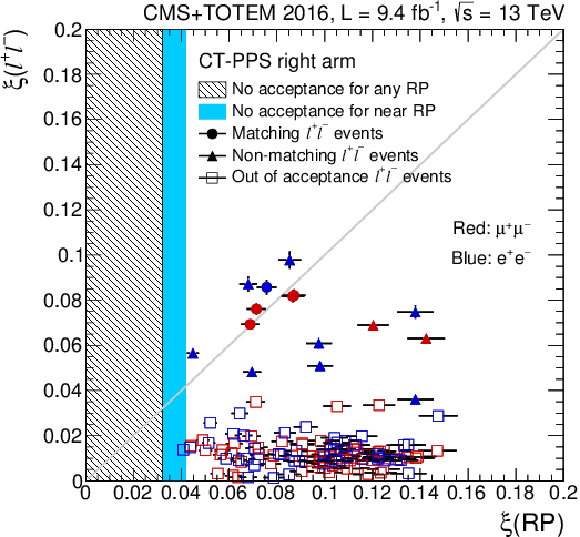
png pdf |
Figure 11-b:
Correlation between the fractional values of the proton momentum loss measured in the central dilepton system, $\xi (\ell ^{+}\ell ^{-})$, and in the RPs, $\xi $(RP), for both RPs in each arm combined. The 56 arms are shown. The hatched region corresponds to the kinematical region outside the acceptance of both the near and far RPs, while the shaded (pale blue) region corresponds to the region outside the acceptance of the near RP. For the events in which a track is detected in both, the $\xi $ value measured at the near RP is plotted. The horizontal error bars indicate the uncertainty of $\xi $ (RP), and the vertical bars the uncertainty of $\xi (\ell ^{+}\ell ^{-})$. The events labeled "out of acceptance'' are those in which $\xi ({{{\mu ^{+}}} {{\mu ^{-}}}})$ corresponds to a signal proton outside the RP acceptance; in these events a background proton is detected with nonmatching kinematics. |

png pdf |
Figure 12:
Expected acceptance regions in the rapidity vs. invariant mass plane overlaid with the observed dimuon (closed circles) and dielectron (open circles) signal candidate events. The "double-arm acceptance" refers to exclusive events, $ {\mathrm {p}} {\mathrm {p}}\to {\mathrm {p}}\ell ^{+}\ell ^{-} {\mathrm {p}}$. Following the CMS convention, the positive (negative) rapidity region corresponds to the 45 (56) LHC sector. |
| Tables | |

png pdf |
Table 1:
Estimated backgrounds from Drell-Yan and double-dissociation ${{{\mu ^{+}}} {{\mu ^{-}}}}$ production, within the acceptance of at least one of the RPs of a given arm, and in the subsample with proton kinematics matching within 2$\sigma $. The bottom row indicates the total background from the sum of Drell-Yan and double dissociation events. |
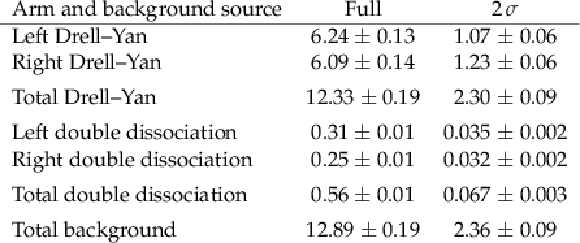
png pdf |
Table 2:
Estimated backgrounds from Drell-Yan and double-dissociation ${{\mathrm {e}^{+}} {\mathrm {e}^{-}}}$ production, within the acceptance of at least one of the RPs of a given arm, and in the subsample with proton kinematics matching within 2$\sigma $. The bottom row indicates the total background from the sum of Drell-Yan and double dissociation events. |

png pdf |
Table 3:
Sources of systematic uncertainties in the estimates of Drell-Yan and double-dissociation backgrounds in the dimuon and dielectron channels. |
| Summary |
| We have studied $\gamma\gamma \to \mu^{+} \mu^{-}$ and $\gamma\gamma \to \mathrm{e}^{+} \mathrm{e}^{-}$ production together with forward protons reconstructed in the CMS-TOTEM precision proton spectrometer (CT-PPS), using a sample of 9.4 fb$^{-1}$ collected in proton-proton collisions at $\sqrt{s} = $ 13 TeV. The Roman Pot alignment and LHC optics corrections have been determined using a high statistics sample of forward protons. A total of 12 $\gamma\gamma \to \mu^{+} \mu^{-}$ and 8 $\gamma\gamma \to \mathrm{e}^{+} \mathrm{e}^{-}$ events are observed with dilepton invariant mass larger than 110 GeV, and a forward proton with consistent kinematics. This corresponds to an excess larger than five standard deviations over the expected background from double-dissociative and Drell-Yan dilepton processes. The result represents the first observation of proton-tagged $\gamma\gamma$ collisions at the electroweak scale. The present data demonstrate the excellent performance of CT-PPS and its potential for high-mass exclusive (proton-tagged) measurements. With its 2016 operation, CT-PPS has proven for the first time the feasibility of continuously operating a near-beam proton spectrometer at a high-luminosity hadron collider. |
| References | ||||
| 1 | J. de Favereau de Jeneret et al. | High energy photon interactions at the LHC | 0908.2020 | |
| 2 | D. d'Enterria, M. Klasen, and K. Piotrzkowski, eds. | High-energy photon collisions at the LHC. Proceedings, International Workshop, Photon-LHC-2008, Geneva, Switzerland, 2008 | volume 179-180(2008) | |
| 3 | CMS Collaboration | Study of exclusive two-photon production of $ W^+W^- $ in $ {\mathrm{p}}{\mathrm{p}} $ collisions at $ \sqrt{s} = $ 7 TeV and constraints on anomalous quartic gauge couplings | JHEP 07 (2013) 116 | CMS-FSQ-12-010 1305.5596 |
| 4 | CMS Collaboration | Evidence for exclusive $ \gamma\gamma \to W^+ W^- $ production and constraints on anomalous quartic gauge couplings in $ {\mathrm{p}}{\mathrm{p}} $ collisions at $ \sqrt{s} = $ 7 and 8 TeV | JHEP 08 (2016) 119 | CMS-FSQ-13-008 1604.04464 |
| 5 | ATLAS Collaboration | Measurement of exclusive $ \gamma\gamma\rightarrow W^+W^- $ production and search for exclusive Higgs boson production in $ {\mathrm{p}}{\mathrm{p}} $ collisions at $ \sqrt{s} = $ 8 TeV using the ATLAS detector | PRD 94 (2016) 032011 | 1607.03745 |
| 6 | S. Atag, S. C. Inan, and I. Sahin | Extra dimensions in photon-induced two lepton final states at the CERN-LHC | PRD 80 (2009) 075009 | 0904.2687 |
| 7 | I. Sahin and S. C. Inan | Probe of unparticles at the LHC in exclusive two lepton and two photon production via photon-photon fusion | JHEP 09 (2009) 069 | 0907.3290 |
| 8 | S. C. Inan | Exclusive excited leptons search in two lepton final states at the CERN-LHC | PRD 81 (2010) 115002 | 1005.3432 |
| 9 | CDF Collaboration | Observation of exclusive electron-positron production in hadron-hadron collisions | PRL 98 (2007) 112001 | hep-ex/0611040 |
| 10 | CDF Collaboration | Search for exclusive $ Z $ boson production and observation of high mass $ p\bar{p} \to \gamma \gamma \to p+\ell\ell+\bar{p} $ events in $ p\bar{p} $ collisions at $ \sqrt{s} = $ 1.96 TeV | PRL 102 (2009) 222002 | 0902.2816 |
| 11 | CMS Collaboration | Exclusive photon-photon production of muon pairs in proton-proton collisions at $ \sqrt{s}= $ 7 TeV | JHEP 01 (2012) 052 | CMS-FWD-10-005 1111.5536 |
| 12 | CMS Collaboration | Search for exclusive or semi-exclusive photon pair production and observation of exclusive and semi-exclusive electron pair production in $ {\mathrm{p}}{\mathrm{p}} $ collisions at $ \sqrt{s}= $ 7 TeV | JHEP 11 (2012) 080 | CMS-FWD-11-004 1209.1666 |
| 13 | ATLAS Collaboration | Measurement of exclusive $ \gamma\gamma\rightarrow \ell^+\ell^- $ production in proton-proton collisions at $ \sqrt{s} = $ 7 TeV with the ATLAS detector | PLB 749 (2015) 242 | 1506.07098 |
| 14 | ATLAS Collaboration | Measurement of the exclusive $ \gamma \gamma \rightarrow \mu^+ \mu^- $ process in proton-proton collisions at $ \sqrt{s}= $ 13 TeV with the ATLAS detector | PLB 777 (2018) 303 | 1708.04053 |
| 15 | CMS and TOTEM Collaborations | CMS-TOTEM Precision Proton Spectrometer | CERN-LHCC-2014-021. TOTEM-TDR-003. CMS-TDR-13 | |
| 16 | G. Ruggiero et al. | Characteristics of edgeless silicon detectors for the Roman pots of the TOTEM experiment at the LHC | NIMA 604 (2009) 242 | |
| 17 | CMS Collaboration | The CMS experiment at the CERN LHC | JINST 3 (2008) S08004 | CMS-00-001 |
| 18 | J. Kaplon and W. Dabrowski | Fast CMOS binary front end for silicon strip detectors at LHC experiments | IEEE Trans. Nucl. Sci. 52 (2005) 2713 | |
| 19 | TOTEM Collaboration | Performance of the TOTEM detectors at the LHC | Int. J. Mod. Phys. A 28 (2013) 1330046 | 1310.2908 |
| 20 | J. Kaspar | Alignment of CT-PPS detectors in 2016, before TS2 | CERN-TOTEM-NOTE 2017-001 | |
| 21 | F. Nemes | LHC optics determination with proton tracks measured in the CT-PPS detectors in 2016, before TS2 | CERN-TOTEM-NOTE CERN-TOTEM-NOTE-2017-002 | |
| 22 | H. Grote and F. Schmidt | MAD-X: An upgrade from MAD8 | in 2003 Particle Accelerator Conference Portland, Oregon, May, 2003 econf C03-05-12 | |
| 23 | TOTEM Collaboration | LHC optics measurement with proton tracks detected by the Roman pots of the TOTEM experiment | New J. Phys. 16 (2014) 103041 | 1406.0546 |
| 24 | J. Kaspar | Elastic scattering at the LHC | PhD thesis, Prague, Inst. Phys., 2011 CERN-THESIS-2011-214 | |
| 25 | J. A. M. Vermaseren | Two photon processes at very high energies | NPB 229 (1983) 347 | |
| 26 | S. P. Baranov, O. Dunger, H. Shooshtari, and J. A. M. Vermaseren | LPAIR: A generator for lepton pair production | in Workshop on Physics at HERA Hamburg, Germany, October 29-30, 1991, p. 1478 1991 | |
| 27 | GEANT4 Collaboration | GEANT4---a simulation toolkit | NIMA 506 (2003) 250 | |
| 28 | J. Alwall et al. | The automated computation of tree-level and next-to-leading order differential cross sections, and their matching to parton shower simulations | JHEP 07 (2014) 079 | 1405.0301 |
| 29 | R. Frederix and S. Frixione | Merging meets matching in MC@NLO | JHEP 12 (2012) 061 | 1209.6215 |
| 30 | T. Sjostrand, S. Mrenna, and P. Z. Skands | A brief introduction to PYTHIA 8.1 | CPC 178 (2008) 852 | 0710.3820 |
| 31 | CMS Collaboration | Event generator tunes obtained from underlying event and multiparton scattering measurements | EPJC 76 (2016) 155 | CMS-GEN-14-001 1512.00815 |
| 32 | Y. Li and F. Petriello | Combining QCD and electroweak corrections to dilepton production in FEWZ | PRD 86 (2012) 094034 | 1208.5967 |
| 33 | CMS Collaboration | The CMS trigger system | JINST 12 (2017) P01020 | CMS-TRG-12-001 1609.02366 |
| 34 | CMS Collaboration | Performance of CMS muon reconstruction in $ {\mathrm{p}}{\mathrm{p}} $ collision events at $ \sqrt{s}= $ 7 TeV | JINST 7 (2012) P10002 | CMS-MUO-10-004 1206.4071 |
| 35 | CMS Collaboration | Performance of electron reconstruction and selection with the CMS detector in proton-proton collisions at $ \sqrt{s} = $ 8 TeV | JINST 10 (2015) P06005 | CMS-EGM-13-001 1502.02701 |
| 36 | CDF Collaboration | Observation of exclusive charmonium production and $ \gamma+\gamma $ to $ \mu^+\mu^- $ in $ p\bar{p} $ collisions at $ \sqrt{s} = $ 1.96 TeV | PRL 102 (2009) 242001 | 0902.1271 |
| 37 | L. A. Harland-Lang, V. A. Khoze, and M. G. Ryskin | The photon PDF in events with rapidity gaps | EPJC 76 (2016) 255 | 1601.03772 |
| 38 | M. Dyndal and L. Schoeffel | The role of finite-size effects on the spectrum of equivalent photons in proton-proton collisions at the LHC | PLB 741 (2015) 66 | 1410.2983 |
| 39 | L. A. Harland-Lang, V. A. Khoze, and M. G. Ryskin | Exclusive physics at the LHC with SuperChic 2 | EPJC 76 (2016) 9 | 1508.02718 |
| 40 | CMS Collaboration | CMS luminosity measurements for the 2016 data-taking period | CMS-PAS-LUM-17-001 | CMS-PAS-LUM-17-001 |

|
Compact Muon Solenoid LHC, CERN |

|

|

|

|

|

|